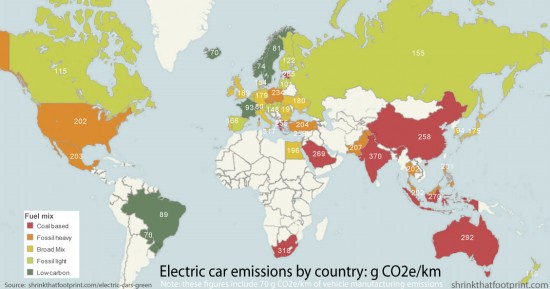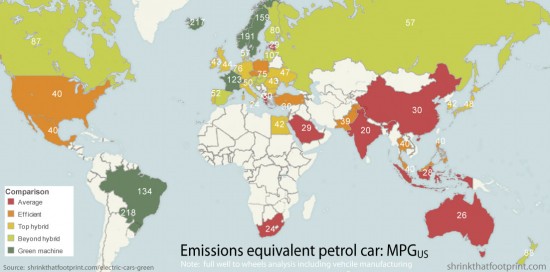Debunking the "Electric Cars Aren't Green" Myth
It’s time to bust this thing wide open.
‘Electric cars aren’t green’ is a great bit of counter-intuitive headline bait, but it’s bad maths. This is how the argument goes, again and again:
Electric cars have higher manufacturing emissions than normal cars. Electric cars also use electricity that has its own footprint. And put together these two factors are a ‘dirty little secret’ that negate any climate benefit of electric cars!
No. Let’s clear this thing up once and for all.
It’s all about the juice
One of the most irritating things about articles discussing electric car emissions is the way it’s always very black and white. In one corner you have the ‘zero emissions’ brigade and in the other the ‘worse than combustion engine’ crew.
But as ever, real life comes in shades of grey.
The reality is that even after you account for the bigger manufacturing footprint of an electric car it is all about the fuel mix of the power you use, the ‘juice’ if you will.
Using coal powered electricity electric cars do nothing to cut emissions, using natural gas electricity they’re like a top hybrid and using low carbon power they result in less than half the total emissions of the best combustion vehicle, manufacturing included.
In our recent study ‘Shades of Green: Electric Cars’ Carbon Emissions Around the Globe’ we calculated grid powered electric car emissions in twenty countries. But we actually had data for quite a few more countries we didn’t include.
So let’s break out the data and put this thing to rest.
Mapping electric car emissions
The following map compares the carbon footprint of electric driving using average grid electricity in 40 or so countries. The actual carbon intensity of electricity you use may differ from the national average for a number of reasons, but it’s a great starting point.
The results are shown in terms of grams of equivalent carbon dioxide per vehicle kilometer (g CO2e/km). Each estimate includes emissions from vehicle manufacturing, power station combustion, upstream fuel production and grid losses.
The specs are based on a full electric vehicle, similar to a Nissan Leaf, using the 2009 average fuel mix in each country. For each country vehicle manufacturing emissions are assumed to be 70g CO2e/km, based on a number of studies detailed in the report.

Of the 40 countries covered in this map emissions vary from 70g CO2e/km in hydro loving Paraguay, up to a 370g CO2e/km in heavy coal using India. The US average is 202g CO2e/km, in China it’s 258g and in Canada 115g.
In Paraguay virtually all the emissions are from vehicle manufacturing, as the power is incredibly low carbon. Whereas in India the breakdown is 70g for vehicle manufacturing, 200g from power plants, 30g for fuel production and a whopping 70g for grid losses.
The colors in the legend split the countries into five different groups based on carbon intensity. As you can see, even after vehicle manufacturing is included the carbon intensity of driving an electric car varies 5 fold based on the juice.
For a bit of reference, the average American gasoline vehicle is up at about 300g CO2e/km, while a new hybrid might manage 180g CO2e/km after you include vehicle manufacturing, fuel combustion and fuel production.
Compared to combustion vehicles
Because grams per kilometer is such a funny metric it is nice to convert these results to something more familiar. Working backwards from the data we can estimate what type of conventional vehicle (if any) would produce similar emissions.
For want of a better phrase lets call this the ‘Emissions equivalent petrol car’.

Now the figures are much easier to get a grip on.
In coal heavy India, China, Australia and South Africa electric cars using grid power are just like typical gasoline vehicles, in the 25-30 MPGUS range. In the UK, Germany, Japan and Italy they are as good as the best petrol hybrids, in the 45-50 MPGUS range. But in low carbon supply places like France, Brazil, Switzerland and Norway they are in a different league, averaging well beyond 100 MPGUS for equivalent emissions.
It is important to remember that the electricity you get might not match your national average for any number of reasons. The night time intensity might vary, you might have solar panels or live in a country like the US, where the grid is actually a bunch of separate grids. For example in Colorado a grid powered electric car is equivalent to about 30 MPGUS, whereas in California it’s up around 70 MPGUS.
For all the comparisons in this map the vehicle manufacturing of a gasoline car is just 40g CO2e/km compared to 70g CO2e/km for the electric vehicle. This is because we have accounted for both a greater manufacturing footprint and lower lifetime mileage in an electric car.
If you are interested in the detail check out the full report. It includes a breakdown of all figures, sensitivities to manufacturing, vehicle performance and comparisons to diesel vehicles.
Electric cars are as green as their juice
Critics of electric cars love to talk about manufacturing emissions and putting horses before carts. But they never seem to offer any better solutions. If they were waxing lyrical about urban densification, electrified public transport and the joys of bicycles their critiques would ring true, but that’s not what you hear.
Electric cars are relatively new at a commercial scale and are dealing with issues of cost, range and charging speed. Each of which will be helped by improving batteries. Despite this they offer enormous hope for reducing carbon emissions, improving local air quality and limiting noise pollution.
Electric cars are far from perfect, and there are plenty of valid ways to critique them. But let’s not pretend that a gasoline vehicle can compete with an electric car in terms of carbon emissions. It’s just not a contest.
Give an electric car the right juice and it crushes combustion engines.
‘Electric cars aren’t green’ is a great bit of counter-intuitive headline bait, but it’s bad maths. This is how the argument goes, again and again:
Electric cars have higher manufacturing emissions than normal cars. Electric cars also use electricity that has its own footprint. And put together these two factors are a ‘dirty little secret’ that negate any climate benefit of electric cars!
No. Let’s clear this thing up once and for all.
It’s all about the juice
One of the most irritating things about articles discussing electric car emissions is the way it’s always very black and white. In one corner you have the ‘zero emissions’ brigade and in the other the ‘worse than combustion engine’ crew.
But as ever, real life comes in shades of grey.
The reality is that even after you account for the bigger manufacturing footprint of an electric car it is all about the fuel mix of the power you use, the ‘juice’ if you will.
Using coal powered electricity electric cars do nothing to cut emissions, using natural gas electricity they’re like a top hybrid and using low carbon power they result in less than half the total emissions of the best combustion vehicle, manufacturing included.
In our recent study ‘Shades of Green: Electric Cars’ Carbon Emissions Around the Globe’ we calculated grid powered electric car emissions in twenty countries. But we actually had data for quite a few more countries we didn’t include.
So let’s break out the data and put this thing to rest.
Mapping electric car emissions
The following map compares the carbon footprint of electric driving using average grid electricity in 40 or so countries. The actual carbon intensity of electricity you use may differ from the national average for a number of reasons, but it’s a great starting point.
The results are shown in terms of grams of equivalent carbon dioxide per vehicle kilometer (g CO2e/km). Each estimate includes emissions from vehicle manufacturing, power station combustion, upstream fuel production and grid losses.
The specs are based on a full electric vehicle, similar to a Nissan Leaf, using the 2009 average fuel mix in each country. For each country vehicle manufacturing emissions are assumed to be 70g CO2e/km, based on a number of studies detailed in the report.

Of the 40 countries covered in this map emissions vary from 70g CO2e/km in hydro loving Paraguay, up to a 370g CO2e/km in heavy coal using India. The US average is 202g CO2e/km, in China it’s 258g and in Canada 115g.
In Paraguay virtually all the emissions are from vehicle manufacturing, as the power is incredibly low carbon. Whereas in India the breakdown is 70g for vehicle manufacturing, 200g from power plants, 30g for fuel production and a whopping 70g for grid losses.
The colors in the legend split the countries into five different groups based on carbon intensity. As you can see, even after vehicle manufacturing is included the carbon intensity of driving an electric car varies 5 fold based on the juice.
For a bit of reference, the average American gasoline vehicle is up at about 300g CO2e/km, while a new hybrid might manage 180g CO2e/km after you include vehicle manufacturing, fuel combustion and fuel production.
Compared to combustion vehicles
Because grams per kilometer is such a funny metric it is nice to convert these results to something more familiar. Working backwards from the data we can estimate what type of conventional vehicle (if any) would produce similar emissions.
For want of a better phrase lets call this the ‘Emissions equivalent petrol car’.

Now the figures are much easier to get a grip on.
In coal heavy India, China, Australia and South Africa electric cars using grid power are just like typical gasoline vehicles, in the 25-30 MPGUS range. In the UK, Germany, Japan and Italy they are as good as the best petrol hybrids, in the 45-50 MPGUS range. But in low carbon supply places like France, Brazil, Switzerland and Norway they are in a different league, averaging well beyond 100 MPGUS for equivalent emissions.
It is important to remember that the electricity you get might not match your national average for any number of reasons. The night time intensity might vary, you might have solar panels or live in a country like the US, where the grid is actually a bunch of separate grids. For example in Colorado a grid powered electric car is equivalent to about 30 MPGUS, whereas in California it’s up around 70 MPGUS.
For all the comparisons in this map the vehicle manufacturing of a gasoline car is just 40g CO2e/km compared to 70g CO2e/km for the electric vehicle. This is because we have accounted for both a greater manufacturing footprint and lower lifetime mileage in an electric car.
If you are interested in the detail check out the full report. It includes a breakdown of all figures, sensitivities to manufacturing, vehicle performance and comparisons to diesel vehicles.
Electric cars are as green as their juice
Critics of electric cars love to talk about manufacturing emissions and putting horses before carts. But they never seem to offer any better solutions. If they were waxing lyrical about urban densification, electrified public transport and the joys of bicycles their critiques would ring true, but that’s not what you hear.
Electric cars are relatively new at a commercial scale and are dealing with issues of cost, range and charging speed. Each of which will be helped by improving batteries. Despite this they offer enormous hope for reducing carbon emissions, improving local air quality and limiting noise pollution.
Electric cars are far from perfect, and there are plenty of valid ways to critique them. But let’s not pretend that a gasoline vehicle can compete with an electric car in terms of carbon emissions. It’s just not a contest.
Give an electric car the right juice and it crushes combustion engines.
You can return to the main Market News page, or press the Back button on your browser.

